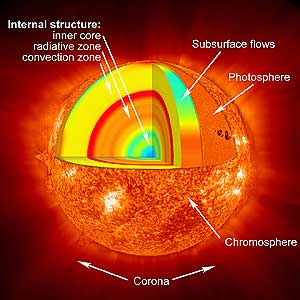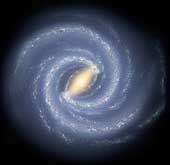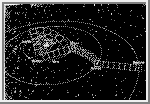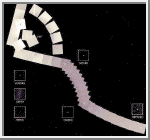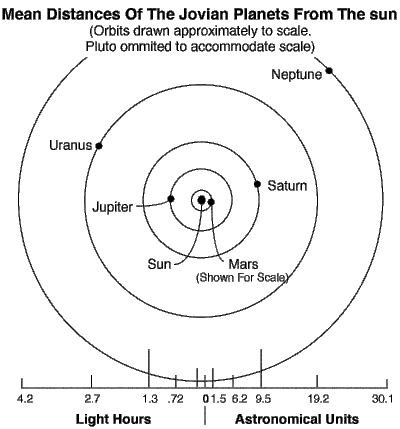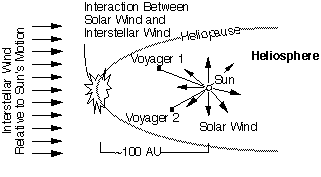For thousands of years it was only a blood-red dot among the starry host---a nameless denizen of the trackless night. Sometimes, when it veered closer to the Earth and shone like a burning coal in the darkness, it must have roused terror among primitive sky watchers, only to fade away into relative obscurity and be forgotten once more. By the time the Egyptians settled their civilization along the banks of the Nile, it had become familiar enough to receive a name---Har décher, the Red One. The Babylonians referred to it as Nergal, the Star of Death, and the Greeks too associated it with warfare and bloodshed---it was the Fiery One, or the war god, Ares---one and the same with the Roman god Mars.
The Babylonians made careful astronomical observations and developed a sophisticated system of arithmetical computations for predicting astronomical phenomena such as eclipses. Their purposes were strictly calendrical and religious, however, and they never attempted to explain the reasons for any of the movements they observed. Superstition was widespread, and many astronomical events were regarded as ominous---not just eclipses but even the risings of Venus were viewed as omens.
It is among the early Greeks that we must look for the first stirrings of a more rational perspective. They identified Mars as one of the five "wandering" stars, or planets, which move relative to the "fixed" stars. Two of the planets---Mercury and Venus---always remain close to the Sun in the sky; their distances never exceed 28° and 47°, respectively, and they may pass between the Earth and the Sun (inferior conjunction) or behind the Sun (superior conjunction). This behavior, as we now know, is due to the fact that their orbits lie inside that of the Earth.
The outer planets---Mars, Jupiter, and Saturn---can appear opposite the Sun in the sky, a situation that is, of course, never possible for a planet that is closer to the Sun than the Earth. When planets appear thus, they are said to be at opposition. It is then that they attain their greatest brilliance. They rise when the Sun sets and set when the Sun rises, so they are highest above the horizon at midnight.
Mars's usual motion among the stars is from east to west. Around the time of opposition, however, it suddenly stops, reverses direction, and moves "retrograde" for a time, then stops again and resumes its usual motion from east to west. (Jupiter and Saturn do this as well, but because they move more slowly---and travel through smaller arcs---the movements are less obvious than in the case of Mars.) So baffling were these motions that Mars was the despair of the naked-eye astronomers. The Roman Pliny, who perished while trying to observe (too closely) an eruption of Vesuvius in A.D. 79, called it "inobservabile sidus"; and at least one later astronomer who attempted to calculate the motions of Mars is said to have become deranged in his mind, and in a fit of rage to have bumped his head against the walls!1
After completing a loop, Mars resumes its westward drift relative to the fixed stars. Its light grows gradually weaker as it approaches and finally passes behind the Sun (into superior conjunction). It then emerges from the Sun into the morning sky and brightens again, until, after two years and two months, it comes once more into opposition and shines like a burning coal upon the night sky.
The ancient Greeks took for granted that the Earth was the center of the universe. They also assumed that the planets moved uniformly in perfect circles. Unfortunately, uniform motion around simple circles did not account for the complicated movements the Greeks actually observed, and they faced the problem of "saving the phenomena"---showing how the observed movements could be reconciled with their principle of uniform circular motions.
One ingenious scheme was introduced by Eudoxus of Cnidus, a mathematician and contemporary of Plato (indeed, he stayed two months in Athens as a pupil at the Academy, though much of his life was spent in Egypt). In the fourth century B.C., Eudoxus developed his system of homocentric spheres, according to which the observed motion of a planet was produced by the independent motions of several internested spheres, each centered on the Earth. The scheme was able to account for the retrograde movements well enough, but it did not explain why, if the spheres shared a common center, the planets varied in their brightness---in the case of Mars, some fiftyfold.
The most obvious explanation for the fluctuations in brightness was that the Earth was not the center of all the motions. By 250 B.C., Aristarchus of Samos, who at least from our modern perspective was the greatest of the ancient astronomers, worked out a complete heliocentric system in which all the planets circled the Sun. Aristarchus regarded Earth as an ordinary planet: it rotated on its axis once every twenty-four hours, and it traveled in a circular path around the Sun with a period of one year. With one bold stroke, he had solved the problem of the retrograde movements, which were now seen to be reflections of the Earth's orbital motion---they are apparent displacements as the planets are viewed from different points as the Earth pursues its course around the Sun.
Unfortunately, Aristarchus was too far ahead of his time, and the later Greeks did not follow his lead. His theory did not account exactly for the observed motions, mainly because, as we now know, the orbits of the planets are not exactly circular, as Aristarchus assumed. The most famous Greek astronomers who lived after him, including Apollonius and Hipparchus, returned to the geocentric system.
In their hands the infamous system of epicycles took shape. The system received its greatest elaboration through the efforts of Claudius Ptolemy, who lived at Alexandria in the second century A.D. and worked it out in detail in his great book The Almagest (The greatest)---thus, the system of epicycles is more commonly known as the Ptolemaic system. Each planet was taken to move around a small circle known as an epicycle, which in turn moved around a larger circle (the deferent) centered on Earth. The combined motion of its epicycle and deferent caused each planet to swing in near the Earth at times, thus producing the retrograde movements. Even apart from the retrograde movements, the planets had a variable motion along the Zodiac; thus Ptolemy made their deferents slightly eccentric to the Earth. Even this did not account for the planets' movements, however, so Ptolemy took still greater liberties. He found a point, the punctum aequans, from which the planet's motion around the deferent would appear uniform---it was located a short distance from the center in the opposite direction from the Earth (a construction known as the "bisection of the eccentricity"). In practical terms, this involved abandoning the principle of uniform circular motions altogether, but it was brilliantly successful as a device for calculating the observed motions of the planets.
Ptolemy's system, despite its artificiality, remained the last word in astronomy for a thousand years. Although the Dark Ages fell on western Europe, putting an end to astronomical investigations there, astronomy was not completely snuffed out. In the East, in Baghdad, Arab scientists continued to observe the stars, and they also attempted to make minor adjustments in the Ptolemaic theory. Only with the revival of learning in Europe, however, was real progress made. The all-important step was taken by Nicolaus Copernicus, a Polish canon at the Cathedral of Frauenburg. Seventeen centuries after the scheme first occurred to the far-sighted Aristarchus, Copernicus reintroduced the heliocentric system. The Sun rather than the Earth was the center of the system, and once again the fact emerged---especially evident in the case of Mars---that the retrograde movements were mere reflections of the Earth's own motion in its orbit. "This happens," wrote Copernicus, "by reason of the motion, not of the planet, but of the earth changing its position in its great circle. For since the earth moves more rapidly than the planet, the line of sight directed toward the firmament regresses, and the earth more than neutralizes the motion of the planet. . . . The inequality attains its maximum for each planet when the line of sight to the planet is tangent to the circumference of the great circle."2
Unfortunately, like Aristarchus's successors Copernicus found that his hypothesis of simple circular orbits around the Sun did not agree exactly with the observed movements of the planets, and he too was forced to introduce complications, including bringing back the cumbersome eccentric circles and epicycles, although in all fairness it must be admitted that he reduced their number. He was also guilty of some surprising inconsistencies. Since the apparent motion of the Sun---actually a reflection of the Earth's orbital motion---is variable during the year, it is convenient to introduce the concept of the mean Sun, whose position is defined by the average rate of the Sun's annual motion. Copernicus referred the planetary motions to the mean Sun rather than to the true Sun, and this forced him to assume that the Earth's orbit had a variable inclination. Despite these shortcomings, he had grasped the essential point; his great book De Revolutionibus Orbium Caelestium (On the revolutions of the celestial spheres) is one of the immortal works of science. It appeared in 1543, the year of his death---it is said that the first copies reached him on his deathbed.
Copernicus's work did not find immediate acceptance. The fiercest resistance came from theologians, but many astronomers were also opposed to his views, including Tycho Brahe, the greatest astronomer of the generation that came after Copernicus's death.
Tycho was an entirely different sort of man from Copernicus. Whereas Copernicus was a theorist first and foremost and made only a few of his own observations, Tycho was mainly an observer---one of the greatest who ever lived.3
He was born in 1546, three years after Copernicus died. He was adopted at birth by a well-to-do uncle, who destined him for a career in statecraft and sent him at age sixteen to the University of Copenhagen to study law. While there, on August 21, 1560, Tycho witnessed a partial eclipse of the Sun, and it changed the direction of his life. The date of the eclipse had been predicted by astronomers, and Tycho, as his early biographer Pierre Gassendi wrote, "thought of it as divine that men could know the motions of the stars so accurately that they could long before foretell their places and relative positions." Before long, he had obtained a copy of Ptolemy's Almagest and worked through it. His uncle disapproved of these studies and sent him away from Denmark, entering him instead at the University of Leipzig with a tutor named Vedel to look after him. Unfortunately, the move was to no avail; Tycho was nothing if not strong-willed. He studied law during the day, and at night, while Vedel slept, stole out to view the stars.
By now Tycho had realized that astronomical tables were not as accurate as he had at first supposed, and also that their reform depended on obtaining more accurate observations. This is what he resolved to do. Not long afterward, his uncle died, and there was no longer anything standing in his way.
From Leipzig, Tycho went to the University of Rostock. During his time there he became engaged in a heated argument with a colleague over a mathematical point. They decided to settle their dispute by fighting a duel, which ended with Tycho having part of his nose cut off (he promptly replaced it with a new one made of copper and wax). From Rostock he went to the University of Basel, then finally returned to Denmark and established a private observatory at Herre Vad, on the estate of another well-to-do uncle.
At Herre Vad, Tycho observed a brilliant new star, or nova, which appeared in the constellation Cassiopeia in 1572. It remained conspicuous for a time, then began to fade, but during the period when it was visible Tycho was able to show that it was exceedingly remote: to all intents and purposes, it was located in the sphere of the "fixed" stars. The book he wrote about the star made him famous, and soon after it was published he received from King Frederik II of Denmark an offer he could not refuse. Frederik granted Tycho the use and revenues of Hven, an island in the Baltic between Elsinore and Copenhagen. Tycho accepted, and in 1576 set up the most splendid observatory in Europe. The instruments there were the best of their day, though needless to say, all were meant to be used for naked-eye observations because the telescope had not yet been invented.
For the next twenty years, Tycho worked at compiling a star catalog whose positions could be trusted to within two or three minutes of arc, and built up an extensive archive of careful observations of the planets, including Mars, which he observed at every opposition beginning with that of 1580. In 1583, he noted that near opposition Mars moved retrograde at a rate of nearly half a degree a day; this proved that Mars could approach much closer to the Earth than the Sun, which was true in the Copernican system but not the Ptolemaic. Nevertheless, Tycho was still not entirely satisfied with the ideas of Copernicus. He adopted a compromise position, known as the Tychonic system, in which the Earth remained at the center; the planets went around the Sun, while the Sun in turn circled the Earth.
It is often said that Tycho was an ill-tempered, quarrelsome man. Unfortunately, this seems actually to have been the case; and he was also an imperious landlord---he was intensely disliked by nearly everyone on the island, and after Frederik's death the Danish court saw fit to cut off his funds. In 1596, Tycho left Hven, taking along with him his observations as well as the more portable of his instruments. He went first to Germany, and then, at the invitation of the Emperor Rudolph II of the Holy Roman Empire, settled at Prague, in Bohemia. The terrible religious wars between Protestants and Catholics were then in full swing, and in 1600 Tycho was joined by a young Protestant mathematician, Johannes Kepler, who had been expelled from his position as mathematician at Graz, Austria, because his religion differed from that of the Catholic Archduke Ferdinand. At that particular time, Tycho and another assistant, Christian Severinus (or Longomontanus, as he styled himself), were working on the theory of the motion of Mars, and Kepler was assigned to the same monumental task. Kepler later remarked that "had Christian been occupied with some other planet, I would have been started on the same one."4
Tycho, who was touchy and jealous of his observations, gave Kepler limited access to his records, and their relationship was undoubtedly strained at times. Miraculously, they managed to avoid a complete break, and on October 24, 1601, Tycho died suddenly, of a bladder ailment. (His last words were, "Let me not seem to have lived in vain.") Kepler was appointed to succeed him, and Tycho's instruments and hoard of observations fell into his hands. At last able to work freely, Kepler returned with a will to his studies of Mars.
Unlike Tycho, Kepler had always been a confirmed Copernican. But where Copernicus had taken the mean Sun rather than the true Sun as the center of the planetary motions, Kepler at once corrected him by making the plane of the Earth's orbit pass through the true Sun. He was rewarded for his consistency with the discovery that the orbit of Mars was inclined to the Earth's by a constant angle of 1° 50¢ (rather than by the variable angle Copernicus had been forced to introduce), whereupon Kepler exclaimed, "Copernicus did not know his own riches!" He next attempted to recalculate the orbit of Mars by referring it, too, to the true Sun. He began by assuming that the planet's orbit was circular but that the speed along this circle was variable. Using Tycho's observations of Mars from 1587, 1591, 1593, and 1595, he struggled to empirically locate a punctum aequans. After numerous trials, he almost succeeded; he produced a theory in which the discrepancy with Tycho's observations was never more than eight minutes of arc at any point around the orbit. This would have satisfied most men, but Kepler had supreme confidence in Tycho's observations, and he rejected this first theory, which he henceforth referred to as his "vicarious hypothesis."
Kepler was not greatly disappointed, since he had never cared for the concept of a punctum aequans. Thinking in physical terms, he could not understand why the motion of a planet should take place with respect to an empty mathematical point. Instead, he believed that the planets moved owing to a force emanating from the Sun. This was only reasonable; after all, their velocity was greatest when they were nearest the Sun and slowest when they were farthest away from it. More precisely, Kepler showed that the radius vector (the line connecting the planet to the Sun) sweeps out equal areas in equal times. This concept has become known as Kepler's second law of planetary motion, though it was actually the first he discovered.
This discovery greatly simplified his calculations, but his main goal---the shape of the Martian orbit---still eluded him. After abandoning the vicarious hypothesis, he resolved to attempt to trace the shape of the orbit without any preconception as to what that might be. His first task was to reexamine the Earth's own motion around the Sun. By considering two of Tycho's observations of Mars in which the planet had been at the same place, but regarding them from the point of view of an observer on Mars rather than Earth, Kepler was able to show that Earth's orbit was as eccentric as those of the other planets. With this information at his command, he constructed tables giving exact distances and longitudes of the Sun, and then, finally, worked out the Mars-Sun distances. Since Mars takes 687 days to orbit the Sun, it will, if measured on two dates 687 days apart, have returned to the same point in its orbit; but the Earth, which completes each revolution in 365.26 days, will be at two different positions for the measurements. If one knows the angle that Mars makes relative to the Sun at these two points, one can define the Sun-Mars distance in terms of the Sun-Earth distance.
In this way Kepler was able to calculate the distance of Mars from the Sun at various points in its orbit. Each time, he found that the distance was less than it would have been had the orbit been circular. This suggested that the orbit was an oval of some kind. In order to simplify his calculations, he began to use the more tractable ellipse as an auxiliary device, on one occasion even writing to his friend, the able observer David Fabricius, that if the orbit actually were an ellipse, the mathematical problem would already have been solved by Archimedes and Apollonius. At the moment he could take the matter no further. His efforts were heroic, and at times he came close to ruining his health. Indeed, he became so worn out that he decided to take off a whole year, 1603, and seek relaxation in researches into optics.
On returning to the "war with Mars" in early 1604, Kepler decided to use Tycho's observations to plot the planet's position in its orbit at twenty-two different points. When he did so, he found that all the points fell within the eccentric circle of the vicarious hypothesis and left a crescent, or lune, on each side between the orbit and the circle itself. He was still thinking that the shape of the orbit had to be an oval of some sort. He noticed that, relative to a circular orbit of radius 1, the distance to the lune at its greatest breadth measured 1.00429. To the casual reader this means nothing, but Kepler had agonized over the orbit of Mars for six years. In his calculations using his areal law, he had made frequent use of the so-called optical equation of Mars, which gives the angle between the Sun and the center of Mars's orbit as seen from the Earth; at this moment he happened to notice (by sheer chance, he said, but his mind had been well prepared) that for the maximum value of this angle, 5° 18¢, the ratio known as the secant is equal to 1.00429. This was the breakthrough he had needed. "I awoke as from a sleep," he exclaimed, "a new light broke upon me." He now grasped the relationship between the center of Mars's orbit and the distance of Mars from the Sun at the lune's widest point, and assumed that this relationship must hold true for any point in the orbit. After a few more trials, he came to his great discovery: the equation that correctly describes the orbit of Mars is that of an ellipse, with the Sun at one focus.
Kepler realized that what held true for Mars must hold true for the other planets: they too must follow elliptical paths. But he also had been fortunate; had he worked on the motions of any other planet, he would never have made this discovery. Apart from Mercury, which is difficult to observe because of its proximity to the Sun, Mars has the most eccentric orbit of the planets known during Kepler's time. Had he begun, say, with the motion of Venus, whose orbit is nearly circular, the solution would doubtless have remained beyond his grasp. Thus Kepler saw it as nothing less than providential that when he had joined Tycho in Prague, Longomontanus had been working on Mars. "In order to be able to arrive at understanding," he wrote, "it was absolutely necessary to take the motion of Mars as the basis, otherwise these secrets would have remained eternally hidden."5
Kepler had discovered his first two laws of planetary motion by 1605, and had also finished his great book, New Astronomy . . . Commentaries on the Motions of Mars.6 To Emperor Rudolph he announced in a fittingly martial metaphor the triumph to which he had been led by his unfailing faith in Tycho's observations and his own relentless efforts:
| I bring to Your Majesty a noble prisoner whom I have captured in the difficult and wearisome war entered upon under Your auspices. . . . Hitherto, no one had more completely got the better of human inventions; in vain did astronomers prepare everything for the battle; in vain did they draw upon all their resources and put all their troops in the field. Mars, making game of their efforts, destroyed their machines and ruined their experiments; unperturbed, he took refuge in the impenetrable secrecy of his empire, and concealed his masterly progress from the pursuits of the enemy. . . . For my part, I must, above all, praise the activity and devotion of the valiant captain Tycho Brahe, who, under the auspices of Frederik and Christian, sovereigns of Denmark, and then under the auspices of Your Majesty, every night throughout twenty successive years studied almost without respite all the habits of the enemy, exposing the plans of his campaign and discovering the mysteries of his progress. The observations, which he bequeathed to me, have greatly helped to banish the vague and indefinite fear that one experiences when first confronted by an unknown enemy.7 |
|
|
Kepler hoped to win support from Rudolph to extend his investigations to the other planets. Rudolph was chronically short of funds, however, and did not have enough money to fight all his battles on Earth, let alone among the stars; even the money to publish Kepler's book on Mars was not immediately forthcoming, and its appearance was delayed until 1609.
The rest of Kepler's life was full of trials. His salary was continually in arrears, his first wife suffered from epileptic seizures and finally died, and his three children succumbed to smallpox. By 1612 Prague itself had become a battleground, and Kepler fled to Linz, in Austria. In spite of it all, Kepler continued his laborious calculations, and in 1619 announced the discovery of his third law of planetary motion---the so-called harmonic law: "The square of the period of revolution is proportional to the cube of the mean distance from the Sun."
The importance of this law is that it holds the key to the scale of the solar system. The relative distances of the planets from the Sun can be determined from their periods. If the periods are expressed in Earth years, the distances follow immediately in terms of the Earth-Sun distance (which equals 1 astronomical unit, or 1 a.u.; thus for Mars, which has a period of 1.881 Earth years and lies at a mean distance from the Sun of 1.524 a.u., 1.8812 = 1.5243 = 3.538).
In 1626, Linz came under siege and Kepler was forced to flee again. Eventually he found refuge at the court of the general-in-chief of the armies of the Holy Roman Empire, Albrecht von Wallenstein, at his newly formed duchy of Sagan, in Silesia. A year later, Kepler published his long-awaited tables of planetary motion, the Rudolphine Tables, named for his former patron, who had died in 1612. But chronic financial worries and overwork were beginning to tell on him. Finally, in October 1630, he set out on a trip from Sagan to Regensburg, where he hoped to confer with the emperor about yet another residence, but the trip proved too much for him, and after a short illness he died on November 15, 1630.
Kepler's laws contain essential facts about the planetary motions. However, they were empirically derived from Tycho Brahe's observations. It was not until later that Isaac Newton, in his majestic Principia of 1687, was able to derive them from a physical theory---his principle of universal gravitation. According to Newton, every body in the universe attracts every other body with a force that is proportional to the amount of matter (mass) each contains and to the inverse square of the distance between them. In the simple two-body case, such as a planet orbiting the Sun or a satellite orbiting its primary planet, the motion of the one around the other is essentially a Keplerian ellipse; but of course matters are not so simple---every planet disturbs the motion of every other, so that when one gets down to the details the actual motions are very complicated.
Mars's motions are now well known. The elliptical path in which it moves is such that its distance from the Sun varies from 206.5 million kilometers at its closest (perihelion) to 249.1 million kilometers at its farthest (aphelion). The mean distance is 227.9 million kilometers. The planet completes each revolution in about 687 days---686.98 days to be exact.
Because of the gravitational pull of the Sun and planets on the tidal bulge in the equator of Mars, its orbit gradually changes over time; the position of its perihelion slowly rotates in space, and the shape of its ellipse is also variable---the current value of the eccentricity is 0.093 (compared with 0.017 for the Earth), but over a period of two million years it ranges between 0.00 and 0.13. I shall have more to say about the consequences of these orbital variations later.
At opposition, Mars and the Earth lie on the same side of their orbits from the Sun, and the two planets make their closest approaches to one another (because of the slight tilt of Mars's orbit relative to that of the Earth, the closest approach of the planet may actually occur as much as ten days from opposition). Since the Earth completes each orbit around the Sun in 365.26 days and Mars in 686.98 days, the Earth will overtake and pass Mars on an average of once every 779.74 days (this is known as the synodic period; the actual interval between oppositions may, however, be as little as 764 days and as much as 810 days).
If the meeting occurs when Mars is near perihelion, the distance of approach will be only 35 million miles (56 million km); if it occurs when Mars is near aphelion, the distance will be more than 61 million miles (100 million km). Since the time between oppositions is longer than the Martian year, successive oppositions are displaced around the orbit of Mars---hence the perihelic oppositions are separated from one another by an interval of fifteen or seventeen years (see appendixes 1 and 2). The last perihelic opposition was on September 28, 1988, when the minimum distance was 36,545,600 miles (58,812,900 km); the next will be on August 28, 2003, when Mars will make a closer approach to the Earth than at any time in the last several thousand years---it will come within 34,645,500 miles (55,756,600 km).
The orientation of the Martian orbit in space is such that the longitude of its perihelion currently lies at 336.06°, that is, in the direction of the constellation Aquarius. The Earth passes this point in space in late August each year, and thus perihelic oppositions always occur in August or September, when Mars is either in Aquarius itself or in nearby Capricorn. The planet then lies well to the south of the celestial equator, so that these oppositions are best observed from southerly latitudes. The reverse is true of the aphelic oppositions, which occur around the time the Earth passes the Martian aphelion (in Leo) in late February---these are best seen from the Northern Hemisphere. The difference in the size of Mars is significant; the apparent diameter of the disk ranges from 25.1" at the perihelic oppositions to only 13.8" at the aphelic ones. It follows that the perihelic oppositions---1877, 1892, 1909, 1924, 1939, 1956, 1971, 1988, etc.---represent the most favorable opportunities for the study of the planet, and these have generally been banner years in the history of Martian exploration.
